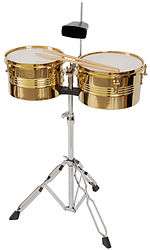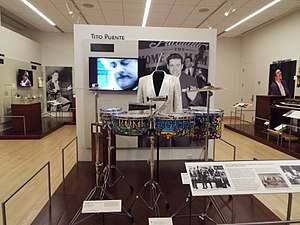Timbales
Timbales (/tɪmˈbɑːliːz/) or pailas are shallow single-headed drums with metal casing. They are shallower than single-headed tom-toms, and usually tuned much higher, especially for their size.[1] The player (called a timbalero) uses a variety of stick strokes, rim shots, and rolls to produce a wide range of percussive expression during solos and at transitional sections of music, and usually plays the shells of the drum or auxiliary percussion such as a cowbell or cymbal to keep time in other parts of the song.
 Timbales with a single cowbell. | |
| Percussion instrument | |
|---|---|
| Other names | Pailas, pailas criollas |
| Classification | drum |
| Hornbostel–Sachs classification | percussion (membranophone) |
| Developed | c. 1900 in Cuba |
| Related instruments | |
| Timpani, bongo drum | |
The shells are referred to as cáscara (the Spanish word for shell), which is also the name of a rhythmic pattern common in salsa music that is played on the shells of the timbales. The shells are usually made of metal, but some manufacturers offer shells of maple and other woods.
Nomenclature

The term timbal or timbales (pl.) has been used in Cuba for two quite different types of drum. Timbales is the Spanish word for timpani (kettledrums), an instrument that was imported into Cuba in the 19th century and used by wind orchestras known as orquestas típicas. These were the same general type of drum used in military bands, perhaps slung either side of a horse, and in classical orchestras. These were, and are, played with mallets (sticks with large, soft, round heads). The timpani were replaced by pailas criollas, which were originally designed to be used by street bands. Pailas are always hit with straight batons (thicker than standard drumsticks, and not shaped: they are of uniform thickness along the length) that have no additional head. Hits are made on the top and on the metal sides. In a modern band the timbalero may also have a trap set to switch to for certain numbers.[2]
Since the term timbales is used to refer to both timpani and pailas criollas, it is ambiguous when referring to bands playing the danzón in the 1900–1930 period.
In French, timbales (pronounced [tɛ̃bal]) is also the word for timpani, thus the French refer to Cuban timbales as timbales latines.
In Brazil, the term timbal refers to an unrelated drum.
Timbalitos
Timbalitos or pailitas are small timbales with diameters of 6″ (15 cm), 8″ (20 cm), or 10″ (25 cm). The timbalitos are used to play the part of the bongos with sticks, but are not used to play the traditional timbales part. Papaíto and Manny Oquendo were masters at playing the bongó part on timbalitos.[3] Timbalitos are sometimes incorporated into expanded timbales set-ups, or incorporated into drum kits.
Traditional use
Baqueteo
The basic timbales part for danzón is called the baqueteo. In the example below, the slashed noteheads indicate muted drum strokes, and the regular noteheads indicate open strokes. The danzón was the first written music to be based on the organizing principle of sub-Saharan African rhythm, known in Cuba as clave.[4]

Timbales bell patterns
During the mambo era of the 1940s, timbaleros began to mount cowbells on their drums. The cowbells, or wood blocks may be mounted slightly above and between the two timbales a little further from the player. The following four timbale bell patterns are based on the folkloric rumba cáscara part. They are written in 3-2 clave sequence.
In the 1970s José Luis Quintana "Changuito" developed the technique of simultaneously playing timbale and bongo bell parts when he held the timbales chair in the songo band Los Van Van. The example below shows the combined bell patterns (written in a 2-3 clave sequence).

Tito Puente was frequently seen in concerts, and on posters and album covers, with seven or eight timbales in one set. The timbales were occasionally expanded with drum kit pieces, such as a kick or snare drum. By the late 1970s this became the norm in the genre known as songo.[5] Changuito and others brought rumba and funk influences into timbales playing. In contemporary timba bands, drummers, such as Calizto Oviedo, will often use a timbales/drum kit hybrid.[6]
Solos
Típico style
The original style of soloing on timbales is known as típico ('typical'). Manny Oquendo (1931-2009) played timbales solos famous for their tastefully sparse, straight forward típico phrasing. The following five measure excerpt is from a timbales solo by Oquendo on "Mambo."[7] The clave pattern is written above for reference. Notice how the passage begins and ends by coinciding with the strokes of clave.[8]
Rumba quinto rhythmic vocabulary
By the late 1940s and early 1950s, some timbaleros ('timbales players'), particularly Tito Puente, began incorporating the rhythmic vocabulary of rumba quinto into their solos.
Non-traditional use
Drummer John Dolmayan of System of a Down is known for using two (6″ and 8″) mini timbales in his kit.[9] Also, Bud Gaugh of Sublime and Long Beach Dub Allstars used a single, high pitched timbal on his drumkit to the left of his snare during his years with those bands. Bud used his timbal usually for accents and transitions, especially in the more reggae-influenced songs, but it is used exclusively in place of the snare on the song "Waiting for My Ruca" from 40 oz. to Freedom and Stand By Your Van. He has not used the timbales in his recent bands Eyes Adrift and Del Mar, possibly due to the lack of reggae influence in those bands. The Ohio University Marching 110's drum line features four sets of timbales in the place of quads or quints. They are one of the very few marching bands in the country to still employ timbales in their drum line. They also employ four sets of dual tom toms to play the lower lines that a quad or quint would cover. An offshoot of the Washington DC funk genre of Go-Go known as the "Bounce Beat" features timbales as a predominant instrument.
Dave Mackintosh uses a pair of 8" diameter attack timbales 9" and 11" deep made by Meinl Percussion[10] to produce a similar sound to a pair of octobans. Meinl also produce a set of mini timbales of traditional depth but 8" and 10" diameter, also suitable for drum kit usage.[11]
Genres
Timbales are traditionally played in:
- Danzón
- Mambo
- Cha-cha-cha
- Pachanga
- Descarga
- Salsa
- Songo
- Timba
- Latin jazz (especially Afro-Cuban jazz)
- Latin rock
- Reggae
Other Latin music genres such as cumbia sometimes incorporate this instrument in lieu of their traditional percussion. Many rock bands have included it in their rhythm section despite not playing Latin rock.
Notable timbaleros
- José "Chepito" Areas
- Guillermo Barreto
- Eric Bobo
- Willie Bobo
- Eguie Castrillo
- Mike Collazo
- Charlie "El Pirata" Cotto
- Ulpiano Díaz
- Sheila E.
- Pete Escovedo
- Frank "El Pavo" Hernández
- Ralph Irizarry
- Kako
- Orlando Marín
- Nicky Marrero
- Osvaldo "Chihuahua" Martínez
- Lance Morgan
- Mario "Papaíto" Muñoz
- Ubaldo Nieto
- Manny Oquendo
- Calixto Oviedo
- Karl Perazzo
- Roberto Plá
- Tito Puente
- José Luis Quintana "Changuito"
- Luisito Quintero
- Marc Quiñones
- Louie Ramírez
- Joseíto Rodríguez
- Louie Romero
- Ray Romero
- Willie Rosario
- Jimmy Sabater
- Bobby Sanabria
- Silvano "Chori" Shueg
- Tony Succar
- Amadito Valdés
- Orestes Vilató
References
- Orovio, Helio 1981. Diccionario de la música cubana: biográfico y técnico. Entries for Paila criolla; Timbal criollo.
- Orovio, Helio 1981. Diccionario de la música cubana: biográfico y técnico. Entries for Paila criolla; Timbal criolla; Típica (orquesta); Charanga.
- Velez, A.E. "Manny Oquendo, Latin Band Leader and Stylistic Innovator, Dies at 78". The New York Times. Retrieved September 23, 2018.
- Peñalosa, David (2010). The Clave Matrix; Afro-Cuban Rhythm: Its Principles and African Origins p. 254. Redway, CA: Bembe Inc. ISBN 1-886502-80-3.
- Moore, Kevin (2011). "The Roots of Timba, Part II; Clave and the Backbeat" Timba.com. Web. http://www.timba.com/encyclopedia_pages/the-clave-and-the-backbeat
- Oviedo, Calixto (2011). "Beyond Salsa Percussion." Timba.com. "Archived copy". Archived from the original on 2012-01-13. Retrieved 2012-01-23.CS1 maint: archived copy as title (link)
- "Mambo" Understanding Latin Rhythms (Patato, et al.) LP Ventures LPV-337-A (1974).
- Peñalosa, David (2010). "Mambo Timbales Solo Excerpt," The Clave Matrix; Afro-Cuban Rhythm: Its Principles and African Origins p. 200. Redway, CA: Bembe Inc. ISBN 1-886502-80-3.
- "Top 9 Timbales For Sale - 2018 Reviews". Instrument Insider. Retrieved October 28, 2018.
- "Archived copy". Archived from the original on January 22, 2013. Retrieved February 28, 2012.CS1 maint: archived copy as title (link) retrieved 28 February 2012
- "Archived copy". Archived from the original on 2012-07-11. Retrieved 2012-02-28.CS1 maint: archived copy as title (link) retrieved 29 February 2012
